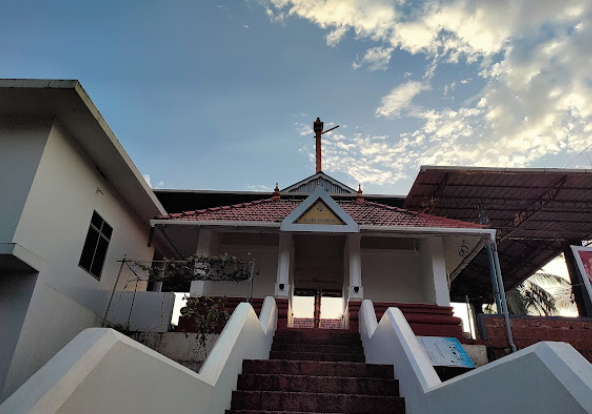Sri Lakshmi Narasimha Swamy Temple is an ancient temple with a history dating back several centuries. It is believed to have been established by local devotees who experienced divine visions of Lord Narasimha and Sri Lakshmi. The temple has undergone various renovations over the years, preserving its traditional Kerala architectural style. It has long been a significant spiritual centre in the region, attracting devotees from far and wide. Historical records and local legends highlight the temple's role in the cultural and religious life of the community. The annual festivals and rituals conducted here continue to maintain the temple's rich heritage.

Narasimha Moorthy Temple
Sri Lakshmi Narasimha Swamy Temple which is also called as Puravoor Sri Lakshmi Narasimha Swamy Temple, is an ancient temple located in Kanji Rod, a village in the Kannur district of Kerala. The temple is dedicated to Narasimha Murthy, the fourth avatar of Lord Vishnu, who is accompanied by Sri Lakshmi. Renowned for its tranquil setting and spiritual atmosphere, the temple features traditional Kerala architecture with intricate carvings and a serene sanctum. It is a revered site for devotees, especially during the annual festivals.
Timings
Morning: 5:30 AM to 9:30 AM & Evening: 5:30 PM to 8:00 PM
Entry Fee
No entry fee is charged
Do's and Don'ts
- Dress Modestly: Wear clothing that covers your shoulders and knees to show respect for the sacred environment. Traditional attire is preferred.
- Maintain Cleanliness: Remove shoes before entering the temple premises and wash your hands and feet if possible. Ensure your offerings are clean and appropriate.
- Speak Respectfully: Keep conversations quiet and avoid loud or disruptive behavior to maintain the temple’s peaceful atmosphere.
- Follow Ritual Procedures: Observe and participate in rituals as directed by the temple authorities. Respect the prescribed order of offerings and prayers.
- Use Designated Areas: Adhere to the designated areas for activities such as eating or resting. Avoid using sacred spaces for non-religious purposes.
- Make Proper Offerings: Consult temple authorities about acceptable items for offerings and ensure they are clean and free from impurities.
- Seek Blessings Respectfully: Offer prayers or mantras silently during your darshan (viewing the deity) to show reverence.
- Support Conservation Efforts: Contribute to and participate in the temple’s conservation and preservation projects to help maintain its heritage.
- Participate in Community Events: Engage in temple festivals and community programs to strengthen communal bonds and preserve cultural traditions.
- Respect Sacred Areas: Follow guidelines regarding the sanctity of the sanctum sanctorum (Sreekovil) and other sacred spaces.
- Avoid Pointing Feet: Do not point your feet towards the deity. Sit cross-legged or kneel to show respect.
- No Non-Vegetarian Food or Intoxicants: Do not consume non-vegetarian food or any intoxicants inside the temple premises.
- Refrain from Loud Perfume: Avoid wearing strong perfumes or colognes. Opt for subtle fragrances to avoid overpowering scents.
- No Unauthorised Photography: Do not take photos inside the sanctum sanctorum or other restricted areas without permission.
- Avoid Littering: Do not litter or cause pollution in the temple premises. Maintain cleanliness to respect the sacred space.
- Do Not Touch Sacred Objects: Avoid touching or handling sacred objects or deities unless instructed by temple authorities.
- No Smoking or Alcohol: Smoking and consumption of alcohol are strictly prohibited within the temple grounds.
- Do Not Engage in Commercial Activities: Refrain from conducting commercial activities such as selling goods or distributing flyers within the temple.
- Avoid Disruptive Behaviour: Do not engage in behaviour that could be considered disrespectful or disruptive, such as arguing or using mobile phones.
- Respect Wildlife: If the temple grounds include natural habitats, do not disturb or feed any wildlife present in the area.
Dress Code
For Men: Wear traditional attire such as dhoti or mundu, and ensure that your upper body is covered. Avoid shorts and sleeveless shirts.
For Women: Opt for traditional clothing like sarees or salwar kameez with modest coverage. Avoid short skirts and sleeveless tops.
How to reach
By Air: The nearest airport is Kannur International Airport (approximately 19 km away). From the airport, you can take a taxi or use public transportation to reach the temple.
By Train: The nearest railway station is Thalassery Railway Station (approximately 30 km away). From the station, taxis and auto-rickshaws are available for reaching the temple.
By Road: The temple is accessible by road from major cities like Kannur and Thalassery. You can use state-run buses or hire a taxi.
Nearby Cities and Rivers
Rivers:
- Valapattanam River: Another river in the Kannur district, it adds to the region's natural beauty and supports local agriculture and activities.
- Pullooppi River : Located in the Kannur district of Kerala, is a small, serene river that flows through the region's lush landscapes. It contributes to the local ecology and provides water resources for nearby communities and agriculture.
Cities:
- Kannur: The temple is situated in the Kannur district, which is a major city known for its cultural heritage, historical significance, and beautiful beaches.
- Thalassery : Thalassery, a city in the Kannur district of Kerala, is renowned for its historical significance, vibrant cultural heritage, and picturesque coastline. It is also known for its contributions to literature, cuisine, and as a centre of trade and commerce.